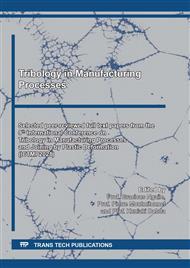p.125
p.133
p.139
p.147
p.155
p.163
p.169
p.179
p.185
Influence of Tool pin Profiles in Friction Stir Welding of Aluminum Alloy and Polycarbonate
Abstract:
In this study, the impact of tool pin profile on the dissimilar joining characteristics of aluminum alloy AA2017 and polycarbonate in friction stir welding (FSW) was examined. The tool pins made of SKD11 tool steel were used in the experiments of the FSW to join AA2017 and polycarbonate plates in a butt configuration at a tool rotation speed of 1320 and 1760 rpm and tool transverse speed of 60 mm/min. The tool shoulder diameter and tool pin height were set to 10 mm and 2 mm. The shapes of tool pin were cylindrical with and without groove, tapered cylindrical with and without groove, bobbin shaped with and without groove, square, triangular, pentagonal, hexagonal, oval, and ellipsoidal. The measurement of axial force was performed using a dynamometer. The changes in workpiece temperature at six locations during the process were measured using K-type thermocouples embedded in the plates. Microstructures of welded joints were examined by an optical microscope. Vickers Microhardness mapping was performed in and around the weld nugget zone, which is formed by the material flow between the two different base materials. From the result, the grooved tool pins generated less heat; while cylindrical, square, and oval type pins are also result in the superior properties of the welds during joining processes. Each tool pin had unique material flow behavior and weld formation, and the weld defects such as tunnel/voids occurred at the joint interface. The oval tool pin gives rise to the highest joint efficiency at a higher tool rotation speed, and the ellipsoidal tool pin generates the highest joint efficiency at a lower tool rotation speed was noticed.
Info:
Periodical:
Pages:
185-190
Citation:
Online since:
February 2022
Authors:
Price:
Сopyright:
© 2022 Trans Tech Publications Ltd. All Rights Reserved
Share:
Citation:


